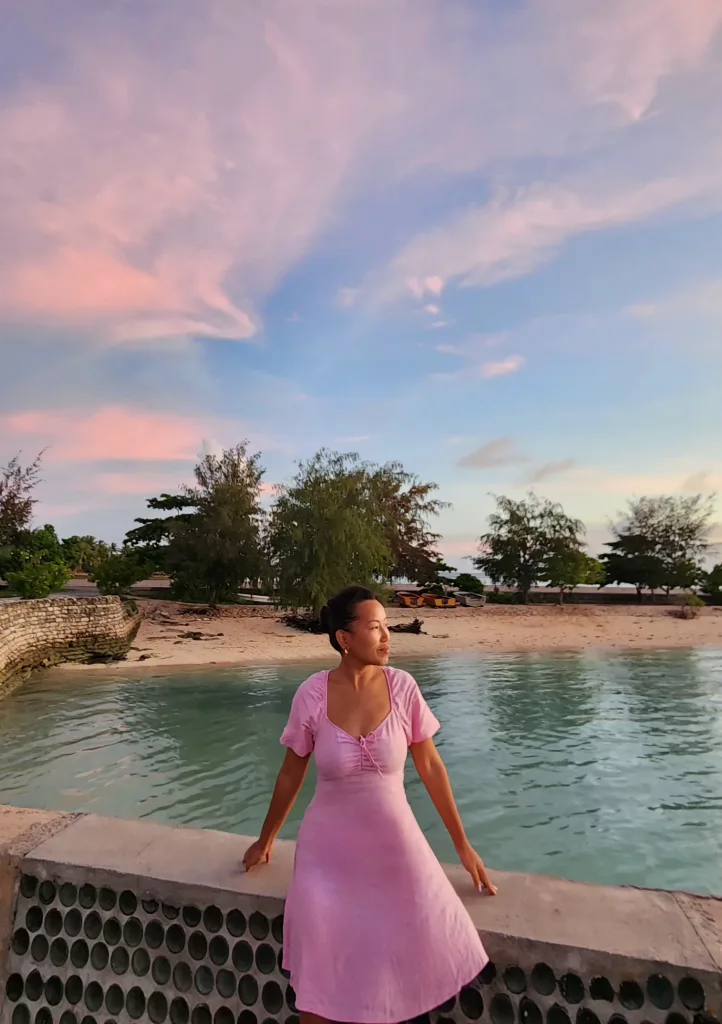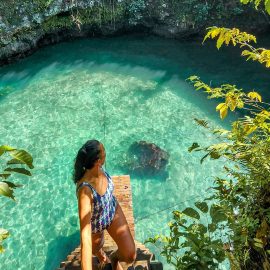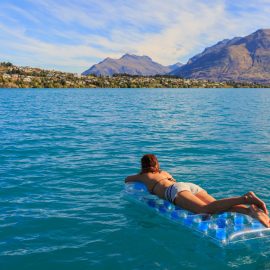After Nauru my next destination in line was country 108 Kiribati, an intriguing and rarely visited island nation with its own unique story. If you are considering solo female travel to Kiribati, read on as I share all my travel tips based on my personal experience.
First thing first, Kirribati is prounced Kiribas. Why you ask well that is because in Gilbertese, the “ti” at the end of “Kiribati” is pronounced as an “s” sound, similar to the English word “see”.Therefore, the Gilbertese rendition of the name, “Kiribati,” is pronounced “Kiribas”. The Gilbertese language (also known as I-Kiribati) is a Micronesian language spoken by the people of Kiribati.
It is located in the central Pacific Ocean, straddling the Equator and comprising 33 low-lying atolls and reef islands scattered over a vast expanse of ocean. The capital is South Tarawa. Visiting Kiribati offers an experience deeply connected to the ocean, with opportunities to witness unique cultural traditions and the challenges faced by low-lying nations in the face of climate change, and to engage with welcoming island communities.
The reality of traveling to Kiribati is shaped by its inter-island transport and international flight connections. For example – in 2025, there are only two flights a week running from Nauru so you either arrive in Friday and leave Monday or stay the whole week. Unlike destinations with frequent arrivals, flights to and between the islands are also limited and require careful planning. As a result, travelers might need to factor in potential longer stays on certain islands depending on transport schedules. However, embracing a lil slower pace allows for a deeper immersion in the island life and a different kind of exploration.
After experiencing other Pacific island nations, arriving in Kiribati will likely be an experience marked by an appreciation for the vastness of the ocean and the resilience of its people in the face of environmental challenges. It’s a place that invites reflection on adaptation and the interconnectedness of island communities. For a solo female traveler drawn to diverse cultures and the realities of our changing world, Kiribati promises to be a unique destination on a global journey.
Solo female travel to Kiribati



Know before you go to Kiribati
Best time to visit
When you have time and resources. Also, the drier season, generally from June to September, is often recommended for more comfortable travel with less rainfall. However, temperatures remain consistently warm throughout the year. Be mindful of the cyclone season, which typically runs from November to May.
Getting Around
Air travel: For travel between the outer islands, domestic flights are available but schedules can be limited and subject to change. Book well in advance.
Ferries and boats: Inter-island ferries and smaller boats are a common mode of transport, offering a more local experience but can be less frequent and have longer travel times.
South Tarawa: On the more populated island of South Tarawa, there are minibuses (often called “buses”) that operate along the main road. Taxis are also available but it’s wise to agree on a fare beforehand.
Outer Islands: Transport on outer islands can be more limited, often involving local boats or arrangements through your accommodation.
Do you need a visa for Kiribati?
For Australians no and for the rest, visa requirements vary depending on your nationality. It’s essential to check the latest visa information with the Kiribati government or the nearest embassy/consulate in your country well in advance of your travel dates. Be prepared to provide necessary documentation, which might include proof of accommodation and onward travel.
Where to stay in Kiribati?



Accommodation options vary across the islands. South Tarawa offers a range of guesthouses and a few hotels. Few recommended ones are – Marys Motel (not to be confused with Mary’s Beach cafe), Betio lodge, Dreamers guesthouse, or Utirerei Hotel.
Recommeded accomodations outside of South Tarawa on islands – Tabon Te Keekee Eco Lodge, Tabuki Retreat, Tebiang Resort, Santa Faustina Homestay, Ocean View Hotel, Terau Beach Bungalow, Abaiang Island, Tarabuka Hideaway Lodge, or Teirio Islet Resort.
On the outer islands, options might be more basic, often consisting of locally run guesthouses or eco-lodges. Research and book your accommodation well in advance, especially if traveling during peak season or to less frequently visited islands. Consider contacting accommodations directly as online booking platforms might have limited listings.
For accommodation, I recommend using booking.com and sorting with price, then consider the ones with highest reviews plus within 1km of centre.
For tours, I recommend using get your guide and walking tours available in most places.
Language spoken
I-Kiribati and English are the official languages. English is used in government and commerce, but learning a few basic I-Kiribati phrases (e.g., Mauri – Hello, Ko rabwa – Thank you) will be greatly appreciated by locals and enhance your interactions.
Currency
Kiribati uses the Australian Dollar (AUD). Similar to other smaller Pacific nations, cash is often preferred, especially on the outer islands and in smaller establishments. While some larger hotels on South Tarawa might accept credit cards, it’s wise to have sufficient AUD cash for your entire stay. ATM availability can be limited, particularly outside of South Tarawa.
Insider Tips
Connectivity can be challenging: Internet access can be unreliable and slow, especially outside of South Tarawa. Embrace the opportunity for a digital detox. Consider purchasing a local SIM card if you need some connectivity, but coverage may vary.
Inter-island travel requires flexibility: Be prepared for potential delays or changes in flight and ferry schedules due to weather or operational reasons. Allow ample time for connections.
Accommodation on outer islands: Be aware that facilities on outer islands may be basic but offer a unique and authentic cultural experience.
Respect local customs: Kiribati has a strong cultural heritage. Dress modestly, especially when visiting villages or attending local events. Ask for permission before taking photos of people. Sundays are often reserved for church and family activities, so expect limited business operations.
Learn about the local environment: Kiribati is on the frontlines of climate change. Understanding the challenges faced by the islands and engaging respectfully with locals about these issues can be a learning experience.
Water can be a precious resource: Conserve water and consider carrying a reusable water bottle. Ask your accommodation about the availability and safety of drinking water.
Embrace the slow pace of life: Island life in Kiribati moves at a different rhythm. Relax, be patient, and enjoy the opportunity to connect with the culture and the stunning natural environment.
3 Days in South Tarawa: Solo Female Travel to Kiribati
Due to the limited flight schedules and the geography of Kiribati, travellers to South Tarawa often find themselves with a few days to explore this fascinating capital atoll. This itinerary focuses on making the most of a short visit to South Tarawa, based on my personal experience and practical considerations.
Day 1: Betio Island exploration and local immersion






Upon arrival at Bonriki International Airport (TRW), I’d complementary hotel transfer to accommodation in South Tarawa. After settling in my room at Marys lodge, near Betio for easy access, I decided to explore Betio Island for the day. This historically significant islet offers a unique blend of wartime history and vibrant local life. For me, staying at Mary’s Motel meant Betio wasn’t far, and I was incredibly fortunate when a kind local lady, accompanied by her adopted daughter (her niece), offered me a ride. This rare and heartwarming interaction provided an invaluable opportunity to glimpse authentic local life. I spent several hours seeing her house, observing the community, and even witnessed a local community dance, for which I’m truly grateful. This unexpected immersion was a highlight of my visit.
Beyond these personal encounters, Betio is home to numerous WWII relics, including rusting Japanese guns, bunkers, and memorials, serving as a poignant reminder of the Battle of Tarawa. You can spend time respectfully exploring these historical sites. The local market areas offer a chance to observe daily life and perhaps pick up some fresh produce. In the afternoon, head back towards Mary’s Cafe for a refreshing drink and a bite. As the day draws to a close, find a good spot to witness the stunning South Tarawa sunset. Dinner at Mary’s Motel was decent for the price, providing a convenient end to a full day.
Day 2: Cultural insights, urban charm, and North Tarawa’s embrace






Start your day with breakfast at your hotel, fueling up for further exploration. Dedicate the morning to gaining some cultural insights. While South Tarawa doesn’t boast grand museums, you can seek out local cultural centers or government buildings that might offer displays or information about Kiribati’s history and traditions. Engaging with locals at markets or community areas can also provide a rich understanding of their way of life.
For lunch, head to Chatterbox Cafe, a popular spot that offers a comfortable environment and a chance to mingle with other travelers or locals. In the afternoon, if you’re seeking a significant shift in scenery and a taste of Kiribati’s natural beauty, it’s highly recommended to head to North Tarawa. This offers a stark contrast to the more densely populated South Tarawa, with more pristine beaches, lush vegetation, and a slower pace of life. For accommodation, Tabon Te Keekee Eco Lodge comes highly recommended as one of the best choices for a truly immersive and tranquil experience. Local buses run along the main road that connects South and North Tarawa, providing an authentic way to travel, or you can opt to hire a car for more flexibility.
Day 3: Nature’s embrace or preparing for departure






Your final day in South Tarawa can be tailored to your flight schedule or personal preferences. If you’ve made your way to North Tarawa on Day 2, spend your last day fully immersed in its taboo nature. Enjoy the tranquility of the untouched beaches, perhaps go for a swim in the clear waters, or simply relax and absorb the peaceful atmosphere. North Tarawa offers a wonderful opportunity for introspection and a complete digital detox. The airport is conveniently closer from this northern part of the atoll, making it a good strategic choice if your flight is on Day 4.
Alternatively, if you’re flying out later in the week or after a longer stay (a week or more), you might consider using this day to explore islands further away within the Kiribati archipelago, if flight or ferry schedules allow. This would require pre-arranged transport and accommodation. For a shorter, 3-day trip focused purely on South Tarawa, using this day to deeply appreciate the natural beauty of North Tarawa before heading to the airport is an ideal way to conclude your visit.
- Outer island excursions: With more time, you can realistically plan a trip to a closer outer island within the Gilbert Group, such as Abaiang or Maiana, by domestic flight or ferry. This offers an even deeper immersion into traditional I-Kiribati village life, away from the relative bustle of South Tarawa. These trips require careful planning for transport and accommodation.
- Community engagement: A longer stay allows for greater community engagement. Attend local church services, sports events, or community gatherings if opportunities arise. Visit local markets more frequently, and build relationships with your hosts and other locals, who are known for their friendliness.
- Leisure and reflection: A week provides ample downtime. Read a book by the lagoon, watch local life unfold, or simply enjoy the simple pleasure of walking the length of an island at your own pace.
- Understanding climate change: Use the extra time to engage with local organizations or individuals working on climate change adaptation, gaining a deeper understanding of the critical challenges faced by this low-lying nation.
Is it safe solo travelling Kiribati?



Overall, Kiribati is generally considered safe for solo female travelers, but it’s crucial to understand that “safe” in this context comes with important caveats regarding infrastructure, cultural norms, and the nature of travel to a very remote and less-developed destination. It’s not a place for those seeking typical resort-style tourism, but rather for intrepid travelers looking for a unique cultural and environmental experience.
Here’s a breakdown of safety considerations for solo female travelers in Kiribati:
Generally low crime rate, but be vigilant
- Petty crime: While violent crime is rare, petty crimes like pickpocketing and purse snatching can occur, especially in more crowded areas like South Tarawa. It’s always wise to secure your belongings and avoid openly displaying valuables.
- Scams: Be cautious of common scams, such as overcharging for services or unsolicited tours. Stick to reputable operators if you choose to book tours.
- Unexploded ordnance: Especially in areas like Betio and other parts of South Tarawa, there’s a risk of unexploded ordnance from WWII. Exercise caution, particularly on beaches, and stick to well-trodden paths.
Specific considerations for solo women travelers
- General safety precautions: As with any solo travel, it’s advisable to avoid walking alone at night, especially in secluded areas. South Tarawa can be less safe after dark.
- Street harassment: Instances of street harassment are relatively rare, and locals are generally friendly and respectful. Dressing modestly and respecting local customs can further help in avoiding unwanted attention.
- Cultural respect: Kiribati is a conservative society. Dressing modestly (shoulders and knees covered, especially when visiting villages or religious sites) is highly recommended and shows respect, which can contribute to a more positive and safer experience. Avoid public displays of affection or nudity.
- Socializing: While making new friends is part of travel, exercise common sense. Avoid advertising that you are traveling alone.
Infrastructure and health
- Limited healthcare: Medical facilities in Kiribati are basic, especially on outer islands. Serious medical conditions may require costly medical evacuation. Comprehensive travel insurance, including medical evacuation coverage, is essential. Bring any necessary prescription medications with you.
- Water and food safety: It’s recommended to drink bottled or boiled water. Be cautious with raw or undercooked food. The lagoon in South Tarawa is polluted, so swimming there is not advised.
- Transportation: Public transport (minibuses) is generally safe but can be crowded. Road conditions can be poor,and inter-island travel relies on boats and domestic flights, which may not always adhere to strict safety standards or schedules. Be prepared for delays.
- Connectivity: Internet and mobile phone services are limited and can be unreliable, especially on outer islands. Be prepared for a digital detox.
Natural hazards
- Cyclones: Kiribati is prone to tropical cyclones, especially from November to April. Monitor weather forecasts and local advisories during this period.
- Tides and currents: Coastal waters can have strong rip tides, particularly beyond the reef. Exercise extreme caution when swimming.
Overall Recommendation: Kiribati can be a safe and incredibly rewarding destination for solo female travelers who are independent, adaptable, and respectful of local customs. The warmth and friendliness of the I-Kiribati people are often highlighted by visitors. However, it requires more preparation and a higher level of self-reliance than more mainstream tourist destinations.
Tips for a travel safety
- Research thoroughly: Understand the local customs, transport options, and potential challenges.
- Inform someone: Share your itinerary with friends or family back home and check in regularly.
- Pack appropriately: Dress modestly to respect local culture.
- Carry cash: Credit cards are not widely accepted.
- Stay hydrated: Drink plenty of bottled or boiled water.
- Be flexible: Embrace the “island time” and be prepared for changes in plans.
- Listen to locals: They are the best source of up-to-date safety advice and local insights.
- Consider travel insurance: Especially one that covers medical evacuation.
By being aware of these factors and taking sensible precautions, a solo female travel to Kirribati can be a truly unique and safe experience. I hope this solo female travel to Kiribati gave you enough insights for your trip. Happy Travels! (follow to watch Nauru visual impressions on my Instagram)
For accommodation, I recommend using booking.com and sorting with price, then consider the ones with highest reviews plus within 1km of centre.
For tours, I recommend using get your guide and walking tours available in most places.
Let me know in the comments:
If you have any questions about Solo female travel to Kiribati
Solo female travel to Tuvalu
Solo female travel to Nauru
3 days in Malta without a car
4 days in Cyprus to one week in Cyprus
5 days backpacking in Tunisia
5 days in Egypt itinerary
3 days in Doha itinerary
5 Days in Oman Itinerary
3 days Kuwait travel blog
5 days in Jordan itinerary
3 Days in Dubai itinerary
Maldives 4 days itinerary
5 days in Tokyo itinerary
1 week in Seoul
7 Days in Bangladesh itinerary
Solo female travel to Georgetown Guyana
Paramaribo itinerary and travel tips
French Guiana tour on a day trip
Backpacking one month in Central America itinerary
How to plan a trip to Argentina 3 weeks to 1 month itinerary
Puerto Rico solo travel itinerary
Backpacking Paraguay itinerary
Solo trip to Peru One month itinerary
Solo female travel Colombia
7 days backpacking in Ecuador itinerary
5 days in Oaxaca itinerary
2 days in Mexico City itinerary
7 Days Itinerary in Georgia
4 Days in Azerbaijan Itinerary
Best places to visit from Split
2 days in Split, Croatia
Solo traveling to Mostar
Solo female travel to Kotor
Solo female travel to Budva
Solo female travel Albania
Warsaw by Train covers warsaw travel tips
One day in Luxembourg, western Europe
Day trip from Zurich to Liechtenstein
Travel tips to South America
Fiji solo travel guide
Australia east coast must-see
Backpacking in Melbourne, Australia
Digital nomad guide to Melbourne
14 best area to stay in Melbourne CBD
Master Sydney travel guide
Solo travel guide to Brisbane
Exploring Adelaide the best way is a must-read
Important travel tips for Uluru trip
Melbourne day trips in winter
Day Hikes in Melbourne
Weekend getaway? Check out things to do in Ballarat
Perth solo itinerary
Top 5 must do in Darwin, Australia
How to go from Dublin to Howth
Solo female travel Romania
Read a recent day trip to Zaanse Schans from Amsterdam
How about a solo itinerary to Canberra– Australia’s capital city?
Solo trip to Peru, travel tips to South America
Check out the 7 days Hanoi travel guide.
Book accommodation through trusted Booking.com
I have detailed travel resources right here. Save money, learn what and how.
If you like this article, I invite you to read about my journey to becoming a solo female Nepali Australian travel blogger, follow my adventures on Instagram, Facebook, YouTube, Twitter, and Pinterest, but most importantly sign up for my e-mail list to keep up with updates and travel posts!



